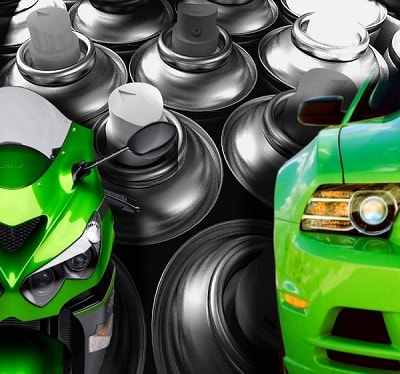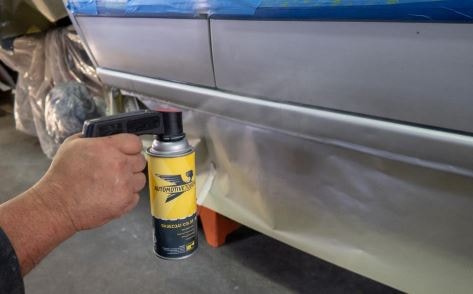All Products are in stock
and shipped from France.
Delivery within 48 hours.
and shipped from France.
Delivery within 48 hours.
Our categories
 How to apply spray paint ?
How to apply spray paint ?
If one wishes to achieve results similar to spray gun painting, the closest method is applying paint with a spray can. Using a spray can allows for a smooth, even coat of paint without brush marks.
A wide variety of paint products are available in aerosol form:
Tutorial: How to Achieve the Best Results with Spray Paint
How does a spray can work?
A spray can is a container that holds both paint and a pressurized propellant gas.
Similar to a spray gun, the paint is projected under pressure through a fine nozzle, atomizing the paint into a mist of micro-droplets, that land on the surface. Unlike roller or brush techniques, only the paint touches the surface, preventing marks, reducing paint consumption, and improving drying time.
Tutorial: 7 Rules for Painting with a Spray Can
Can you achieve results comparable to a professional automotive painter? The answer is yes—provided you work on small surfaces and follow some essential techniques and gestures.
- 1. Shake the spray can well before painting – Shake the aerosol for 30 seconds and ensure you hear the metallic ball mixing the pigments.
- 2. Perform a spray test on a surface – If an issue arises, press firmly on the nozzle, check if the paint conduit is clogged, turn the can upside down and purge it, then try spraying again.
- 3. Use left-to-right and right-to-left movements – Avoid crossing layers horizontally and vertically. The movement speed should be consistent: if too fast, the applied paint layer will be too thin.
- 4. Maintain the correct distance (10-15 cm) and a 90° angle to the surface – The painter’s wrist should be flexible and follow the surface’s contours.
- 5. Fully press the aerosol’s trigger – The spray intensity cannot be adjusted manually. To apply thin coats, use quick passes.
- 6. Wipe the spray can's rim every minute – This prevents paint buildup that could result in paint drops on the surface.
- 7. Purge the spray can upside down after use – This prevents clogs due to dried paint and ensures the aerosol can be reused without issues.

Painting large surfaces with a spray can
Applying multiple coats and covering large areas can quickly cause finger strain and fatigue. In such cases, using a plastic spray can handle is recommended to improve grip, reduce fatigue, and even control layer thickness.
2 types of nozzles
There are mainly two types of spray nozzles for aerosol paints:
Flat jet nozzle – Produces a flat, triangular spray, ideal for painting flat and curved surfaces similarly to a paint gun. Round jet nozzle – Produces a concentrated, circular spray (up to 8 cm wide). This type of nozzle is particularly suitable for painting chassis, gates, bicycles, or any tubular structures.
 1K or 2K Automotive Spray Paints
1K or 2K Automotive Spray Paints
As with automotive paints, spray paints are available in 1K or 2K versions:
1K metallic and pearlescent paints – These are fine, single-component paints that dry very quickly. They have a matte finish and must be covered with a clearcoat.
2K paints and clearcoats – These are glossy, durable finishing products. All professional versions are two-component aerosols (2K).
Application Differences:
→ 2K paints and clearcoats – Apply with slow passes to create glossy, thick layers, allowing 7-10 minutes of drying between coats. Always apply two coats.
→ 1K metallic and pearlescent paints – Apply with quick passes to create thin layers, with 2-minute intervals between coats. Apply as many layers as needed for full coverage.
Two-Component Aerosol Paints (2K)
Stardust offers containers with a built-in hardener that activates with a button. This feature creates extremely durable paint. However, the downside is that once activated, the product has a limited lifespan of just one hour.
Spray Can Capacity
In France and worldwide, spray cans contain one part paint for every three parts propellant gas to maintain pressure in the can.
In practical terms, this means that for a declared total of 400 ml, the actual content of usable paint or varnish is 100 ml.
In summary, Spray cans are extremely convenient, allowing anyone to apply paint without equipment, connections, or cleaning. However, they are not the most cost-effective painting method.
Safety Precautions
It is crucial to take maximum precautions when using aerosol paint. Most spray cans contain highly flammable gas. Always spray away from any heat source or ignition risk. Additionally, always work in a well-ventilated area to allow proper gas circulation.
Painting with an airbrush
Chrome Plating Machines
Spray Painting with a Spray Gun














































































